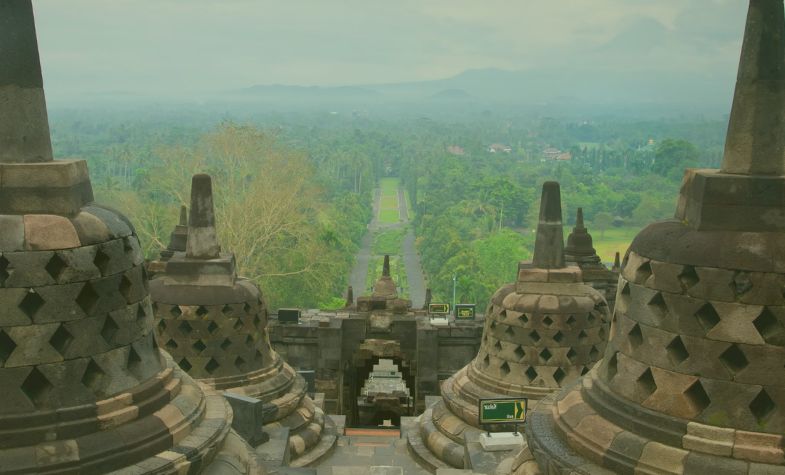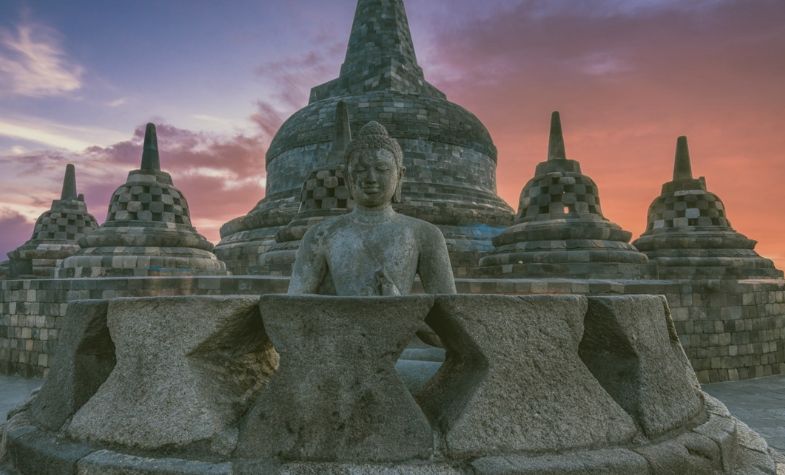

Located in Central Java, Indonesia, Borobudur Temple is one of the most iconic and awe-inspiring landmarks in Southeast Asia. This ancient Buddhist temple, dating back to the 9th century, is not only a UNESCO World Heritage site but also a testament to Indonesia’s rich cultural and religious history. With its grand structure, intricate carvings, and spiritual significance, Borobudur attracts millions of visitors each year who come to marvel at its beauty and learn about the fascinating history behind it.

Borobudur is the world’s largest Buddhist temple and a magnificent example of ancient Javanese architecture. It was built during the reign of the Sailendra dynasty, around the 9th century, and was abandoned by the 14th century, likely due to the decline of Buddhism in Java. The temple remained hidden under volcanic ash for centuries until it was rediscovered in the 19th century.
The structure is a massive pyramid-like temple, made up of nine stacked platforms, including six square and three circular levels, topped by a large stupa in the center. The temple’s design is intended to represent the Buddhist concept of the universe, with the lower levels symbolizing the earthly realm, and the upper levels representing the spiritual journey toward enlightenment.
Borobudur is not just an architectural wonder; it holds deep religious and cultural significance. It is considered a sacred site for Buddhists, and pilgrims have visited the temple for centuries to meditate and reflect. The temple’s design is deeply symbolic, with over 2,600 intricate relief panels and 504 Buddha statues that tell the story of the life of Buddha and the path to enlightenment. The panels illustrate the teachings of Buddha, covering topics such as karma, rebirth, and the journey toward Nirvana.
Every year, Borobudur becomes a focal point for religious observances, including the famous Waisak (Vesak) festival, which celebrates the birth, enlightenment, and death of Buddha. During this event, thousands of Buddhists gather to participate in processions, prayer, and meditation at the temple.

One of the most captivating aspects of Borobudur Temple is The Relief Panel, which covers the walls of the temple’s structure. These intricate carvings tell the story of the Buddha’s life, as well as illustrating key Buddhist teachings like karma, rebirth, and the pursuit of enlightenment. The attention to detail in these carvings is truly remarkable, offering visitors a visual journey through ancient Buddhist thought, and it’s one of the most unique features of the temple.
Another highlight of Borobudur is the Buddha statues that sit within 72 small stupas, located on the upper terraces. Each of these stupas houses a Buddha statue in a serene, meditative pose, representing the various stages of enlightenment. The largest stupa, found at the very top of the temple, symbolizes Nirvana, the ultimate state of spiritual freedom.
Finally, the view from the top of Borobudur is nothing short of breathtaking. The temple is located in a valley surrounded by lush greenery, and from the upper levels, visitors can enjoy panoramic views of the majestic Merapi and Merbabu volcanoes in the distance. Many choose to visit the temple early in the morning to catch the sunrise, which casts a golden glow over the ancient structure and the surrounding landscape, creating an almost mystical atmosphere that enhances the experience of this UNESCO World Heritage site.
The best time to visit Borobudur Temple is during the dry season, from April to October. The weather is typically clear, making it ideal for sightseeing and photography. If you want to experience the temple in a more serene and spiritual atmosphere, visiting during sunrise is highly recommended. Watching the first light of day break over the temple’s massive stone structure is a breathtaking experience.
If you visit during the rainy season (November to March), expect fewer crowds, but be prepared for occasional downpours, which could limit outdoor exploration.
Borobudur Temple is located about 40 kilometers northwest of Yogyakarta, a major city on the island of Java. Yogyakarta is well connected by air, train, and bus to other parts of Indonesia, and from there, you can take a taxi, minibus, or private tour to reach the temple.
If you’re staying in Yogyakarta, a half-day or full-day trip to Borobudur is easily possible, with many local tour operators offering guided visits to the temple, often combined with a trip to the nearby Prambanan Temple.
***
Travel Authentic Asia Company is your best choice for discovering the beauty of Southeast Asia. Our experienced and knowledgeable travel advisors are committed to helping you create a tailor-made tour and extraordinary experiences in this majestic region.
If you're looking for an authentic cultural experience, do not hesitate to contact Travel Authentic Asia to choose a Vietnam tour, Southeast Asia tour package or to customize your own style tour to South East Asia.